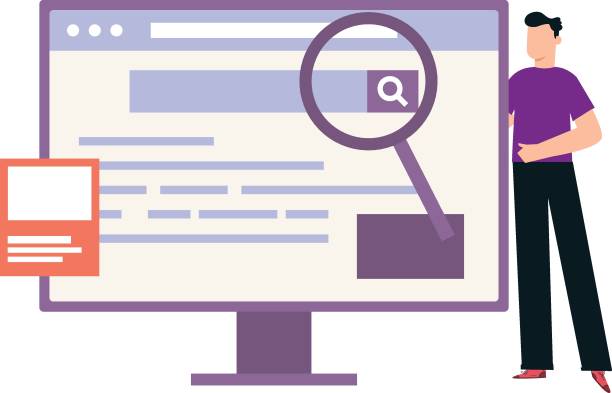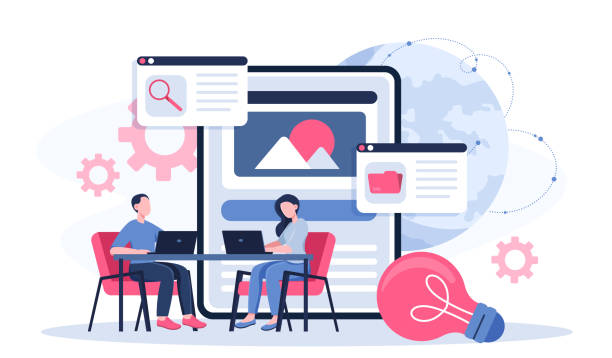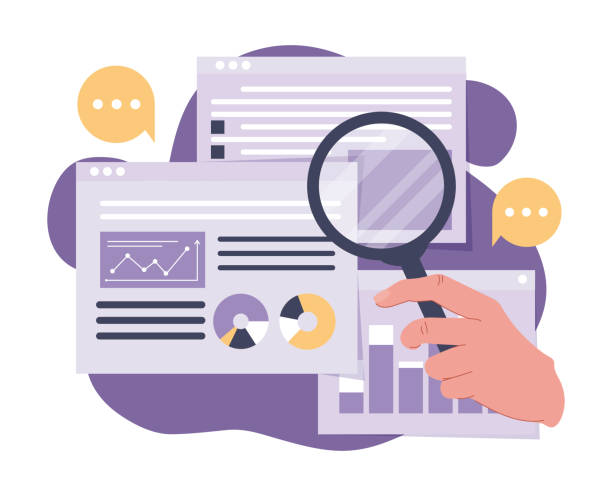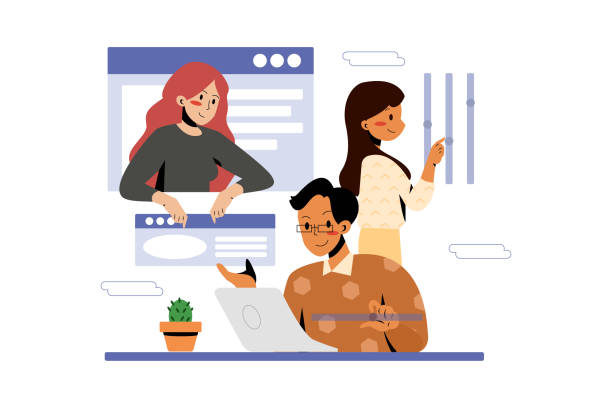Introduction to Website Design with Modern User Interface and Its Importance

In today’s digital age, #website_design is not just about having an online presence, but about creating a memorable experience for users.
Modern User Interface (UI) website design goes beyond mere aesthetics, focusing on how users interact with the website.
This approach emphasizes a smooth, intuitive, and pleasant #user_experience (UX), enabling visitors to easily access the information they need and perform their desired actions.
The importance of this lies in the fact that your website will be the first point of contact for many customers with your brand.
An outdated and inefficient user interface can quickly drive visitors away and destroy business opportunities.
Conversely, modern UI website design not only improves your website’s appearance but also directly impacts conversion rates, user retention time, and ultimately, your business success.
In this section, we will explain the concept of a modern user interface in a descriptive and educational manner and clarify why investing in it is crucial.
In a highly competitive world, differentiating yourself through a superior user interface can be your winning card and encourage users to return to your website again and again.
Are you dissatisfied with the low sales of your online store?
Rasaweb is your solution for having a professional and high-selling online store.
✅ Significant increase in sales and revenue
✅ Easy and enjoyable shopping experience for customers
⚡ Get a free consultation from Rasaweb right now!
Key Principles in Modern UI Design for Websites

To achieve modern UI website design, one must adhere to a set of key principles and guidelines.
The first and most important principle is simplicity and minimalism.
Eliminating unnecessary elements and focusing on the main content helps users reach their goal without confusion.
This minimalist approach significantly improves loading speed and overall user experience.
The second principle is responsiveness.
Given the diversity of devices, a modern website must display correctly on any screen size, from mobile to desktop.
This capability ensures that the user experience is consistent and optimized across all platforms.
Intuitive and understandable navigation is the third principle; users should be able to easily move around your website and search for the information they need.
Using clear visual hierarchies, appropriate typography, and a harmonious color palette are other specialized principles that play a vital role in modern UI website design.
Colors and typography not only affect aesthetics but can also convey subconscious messages and evoke specific emotions in the user.
Adhering to these principles means designing a user-friendly and effective user interface that converts visitors into loyal customers.
In summary, these guidelines help you create a powerful and impactful user interface.
The Role of UX in the Success of Modern UI Website Design

User Interface (UI) and User Experience (UX) are two sides of the same coin in modern UI website design, highly interdependent and complementary.
While UI deals with the look and feel of a website, UX focuses on how the user interacts with it, how they feel, and the ease of use.
A beautiful user interface without a strong user experience is like a luxury car without a powerful engine; it looks attractive but doesn’t provide the necessary performance.
True success in web UI optimization is achieved when designers deeply address user needs, behaviors, and expectations.
This is where User Research, User Testing, and feedback collection become crucial.
By accurately understanding the audience, a website can be designed that not only looks beautiful but also effectively addresses user problems and smooths their path to their goals.
For instance, if users cannot easily find a product or the purchase process is complicated, even the best UI cannot compensate for poor UX.
Modern user experience design means creating a seamless and logical User Journey that guides the user towards their goal at every step.
This comprehensive approach ensures that modern UI website design is not only visually appealing but also performs flawlessly.
New Tools and Technologies in Web UI Design

Recent advancements in tools and technologies have further facilitated modern UI website design.
Today, designers have access to a rich set of software and frameworks that enable the creation of visual, user-friendly, and high-performing websites.
In the specialized section of this article, we introduce some of the most important ones.
Among the most popular UI design tools are Figma, Sketch, and Adobe XD.
These tools, with their online collaboration capabilities, rapid prototyping, and design systems, have made the process of advanced UI web design more efficient.
Figma, in particular, being browser-based, has revolutionized how design teams work by enabling real-time team collaboration.
Alongside design tools, front-end technologies also play a key role in implementing these designs.
JavaScript frameworks like React, Vue.js, and Angular allow developers to build dynamic and interactive websites with excellent performance.
These frameworks, with modular design patterns and performance optimizations, ensure a smooth and fast user experience.
Additionally, the use of modern Content Management Systems (CMS) like WordPress, with advanced templating capabilities and design plugins, enables businesses to implement and manage a modern UI website design without complex coding.
These news developments indicate the direction the web design industry is moving towards: greater efficiency, better collaboration, and stunning visual results.
Do you dream of a thriving online store but don’t know where to start?
Rasaweb is your comprehensive solution for designing an online store.
✅ Attractive and user-friendly design
✅ Increased sales and revenue⚡ Get a free consultation
Current Trends in Modern UI Website Design

The world of modern UI website design is constantly evolving, and each year we witness the emergence of new trends that enrich users’ visual experience.
In this analytical and entertaining section, we delve into some of the most important current trends adopted by leading websites.
One of the most prominent trends is Dark Mode, which is not only beneficial for reducing eye strain in low-light environments but also gives websites a sleek and modern look.
Smart use of Whitespace and minimalist design continues to be a focus, as it allows content to shine and prevents visual clutter.
Micro-interactions, such as small effects when clicking a button or hovering over an element, add depth to user interaction with the website and make the experience more enjoyable.
Custom illustrations, subtle animations, and bold typography are also among the trends that give websites a unique identity and can visually and engagingly narrate the brand story.
Furthermore, we are witnessing an increased use of Voice User Interfaces (Voice UI) and the integration of Artificial Intelligence into the user experience, allowing users to interact with websites in entirely new ways.
These trends indicate that modern UI website design is not limited to visual aesthetics but seeks to create deeper, more functional, and personalized user experiences that delight users.
Challenges and Solutions for Modern UI Website Design for Businesses

Implementing modern UI website design, while offering numerous benefits, also comes with challenges that businesses must address.
One of the most important challenges is maintaining optimal performance and loading speed.
Modern designs often include complex visual elements, animations, and high-quality images that can slow down website loading.
The solution to this issue is to use image optimization techniques, code compression, and Content Delivery Networks (CDN).
Another challenge is Accessibility.
A website with a modern user interface must be usable for all users, including those with disabilities.
This requires adhering to WCAG standards, using alt tags for images, and ensuring keyboard navigability.
Furthermore, maintaining compatibility across different browsers and various devices is also challenging; responsive design and comprehensive cross-browser testing are essential solutions for this problem.
Scalability and website maintenance after launch can also become a challenge; using well-documented design systems and clean coding helps reduce long-term maintenance costs and time.
Finally, convincing stakeholders to invest in modern UI website design, due to higher initial costs, can be a challenge.
However, by providing precise analyses of Return on Investment (ROI) and competitive advantages, these obstacles can be overcome.
These guidelines and analyses help businesses approach modern UI website design with a clearer perspective.
Case Study of Successful Website UI Design

To better understand how to implement a successful modern UI website design, looking at real-world examples can be very instructive.
In this analytical and educational section, several examples of websites that have excelled in UI and UX are examined.
For example, the Airbnb website, by focusing on high-quality images, simple navigation, and an intuitive booking process, has created an unparalleled experience for its users.
Its minimalist design and smart use of whitespace help users easily find what they are looking for.
Another example is the Stripe website, which, with its very clean design, clear documentation, and focus on small details, presents even the most complex technical concepts in an understandable and elegant way.
Its user interface gives developers a sense of familiarity and ease.
The Apple website is also a prime example of modern UI website design that offers a luxurious and immersive experience by using large, high-quality images, subtle animations, and focusing on product storytelling.
These websites share common characteristics: simplicity yet functionality, attention to detail, high speed, and accessibility. These features ensure that users are not only visually attracted but can also easily achieve their goals and have a positive and memorable experience with the website.
This case study provides practical guidance for anyone looking to implement modern UI website design for their project.
The Future of Modern UI Website Design: AI and Beyond

The future of modern UI website design is full of exciting potentials that will push the boundaries of human-computer interaction further than ever before.
One of the most important players in this arena is Artificial Intelligence (AI).
AI can revolutionize the design process by automating repetitive tasks, analyzing user data to identify patterns, and even generating initial designs.
Imagine an AI system that automatically personalizes the user interface and displays content in the best possible way, based on user preferences and behavioral data.
This capability allows designers to focus more on creative and strategic aspects.
Beyond AI, we will witness the growth of Immersive UIs using Virtual Reality (VR) and Augmented Reality (AR) on the web.
These technologies can offer entirely new user experiences, from 360-degree virtual tours to product previews in the user’s real space.
Additionally, voice and gesture-based interactions are expected to play a larger role in web UI optimization, paving the way for more natural interactions.
These developments not only signify a news advancement in technology but also raise a deeper question: Is modern user experience design moving towards complete integration with human daily life? This is a thought-provoking content that requires further examination.
Nevertheless, it is clear that modern UI website design in the future will be even more personalized, intelligent, and immersive.
Does your current online store design not generate the expected sales for you?
Rasaweb specializes in professional online store design!
✅ An attractive and user-friendly website aimed at increasing sales
✅ High speed and security for an ideal shopping experience⚡ Get a free online store design consultation with Rasaweb!
Practical Tips for Ordering and Implementing Modern UI Website Design

Ordering and implementing a modern UI website design requires a systematic approach and close collaboration between the client and the design and development team.
This section provides practical and specialized guidance.
The first step is accurately defining goals and target audiences.
Before starting any design, it must be clearly specified what goals the website aims to achieve and who its audience is.
This information helps the design team create a user-centered interface.
The second step is choosing a reputable design team or agency that has sufficient experience in advanced UI web design.
Previous portfolios and the team’s ability to understand your needs are important selection criteria.
Continuous and transparent communication between the client and the project team is crucial.
Regular meetings, providing constructive feedback, and mutual understanding of expectations can prevent misunderstandings and contribute to smooth project progress.
Additionally, allocating sufficient budget for various stages of design, development, testing, and maintenance is essential.
A quality modern UI website design is an investment whose return will be visible in the long term.
Finally, after launching the website, monitoring performance and gathering user feedback is vital.
Web analytics tools (like Google Analytics) can provide valuable information about user behavior that will be useful for future UI optimizations.
Remember that web design is a continuous process and requires regular updates to maintain its efficiency and modernity.
Conclusion: Why Investing in Modern UI Website Design is Essential?

Ultimately, it is clear that modern UI website design is no longer a luxury choice but a strategic necessity for any business or individual seeking success in the digital space.
As explained in previous sections, a modern user interface goes beyond a beautiful appearance; it is a powerful tool for increasing user engagement, improving conversion rates, and strengthening customer loyalty.
A website with a modern user interface provides a smooth and pleasant user experience that makes visitors stay on your site longer, interact with content, and ultimately become loyal customers or users.
In today’s competitive world, where users can access your competitors’ websites with just one click, modern UI website design helps you differentiate yourself from competitors and build a stronger brand image.
This investment is, in fact, an investment in the future of your business.
By applying user-centered design principles, leveraging new tools, and paying attention to future trends, you can ensure that your website remains relevant and effective not only today but also in the years to come.
Therefore, if you are looking to increase conversion rates, improve SEO, and create an unforgettable digital experience for your audience, it is time to seriously consider modern UI website design and entrust this process to its specialists.
Frequently Asked Questions
| No. | Question | Answer |
|---|---|---|
| 1 | What does modern user interface mean in website design? | It means designing a website that has a beautiful, attractive, and up-to-date appearance, and at the same time, is easy, intuitive, and enjoyable for the user to use (emphasis on UX/UI). |
| 2 | What are the main features of a modern user interface? | Includes minimalist design, sufficient use of white space, attractive typography, a harmonious color palette, high-quality images and icons, full responsiveness, high loading speed, and appropriate use of animations and micro-interactions. |
| 3 | Why is having a modern user interface important for a website? | It improves user experience, increases visitor trust, reduces bounce rate, increases user time on site, strengthens branding, and ultimately helps achieve business goals (such as sales or user acquisition). |
| 4 | What is the role of Responsive Design in modern user interface? | Responsiveness is a vital component; a website with a modern user interface must display correctly and perform optimally on all devices (mobile, tablet, desktop). |
| 5 | How does typography (font selection) affect a modern user interface? | Appropriate typography enhances readability, defines information hierarchy, and plays a significant role in creating a modern visual feel that aligns with brand identity. |
| 6 | What is the importance of using Whitespace in modern design? | Whitespace allows visual elements to “breathe,” prevents clutter, increases user focus on primary content, and creates a clean and professional appearance. |
| 7 | What role do Micro-interactions play in improving a modern user interface? | Micro-interactions (such as button color changes on click, form submission confirmation messages) provide visual feedback to the user, make site usage more interactive and enjoyable, and convey a sense of attention to detail. |
| 8 | What tools are used for modern user interface design? | Common tools include Figma, Sketch, Adobe XD, and even Prototyping Tools. |
| 9 | How can one ensure that a modern user interface is also Usable? | Through User Testing, gathering feedback from real users, adhering to Accessibility principles, and Intuitive Navigation. |
| 10 | Does modern design mean removing all graphic elements? | No, being modern means intelligent and purposeful use of graphic elements, colors, images, and animations to create an attractive yet functional experience, not their unnecessary removal. |
And other advertising services of Rasaweb advertising agency
Placing ads for adjustable monitor stands on digital websites
Advertising high-capacity laptop power banks on sales websites
Introducing advanced security locks on online portals
Advertising compact wireless keyboards on commercial websites
Promoting fast-charging hubs on specialized websites
And over hundreds of other services in the field of internet advertising, advertising consultation, and organizational solutions
Internet Advertising | Advertising Strategy | Advertorials
🚀With Rasaweb Afarin, take your business to the peak in the digital world! We pave the way for your online success by providing comprehensive digital marketing agency services, including responsive website design, SEO, and content creation.
📍 Tehran, Mirdamad Street, next to Central Bank, Southern Kazeroun Alley, Ramin Alley, No. 6

